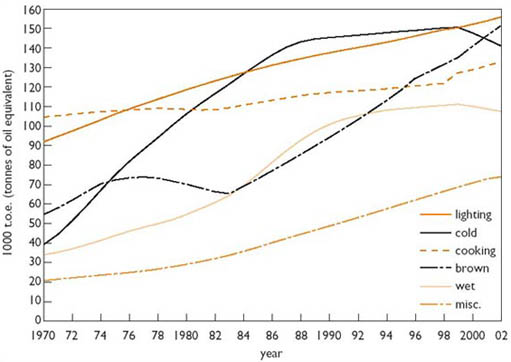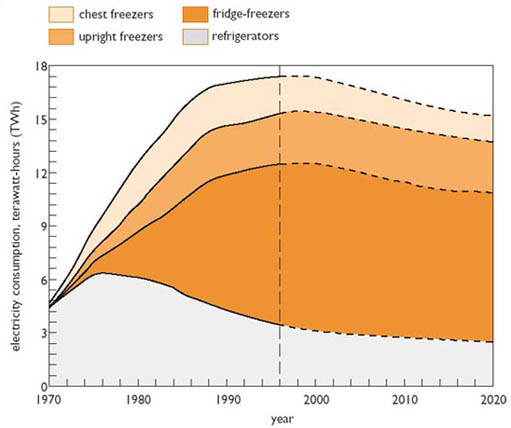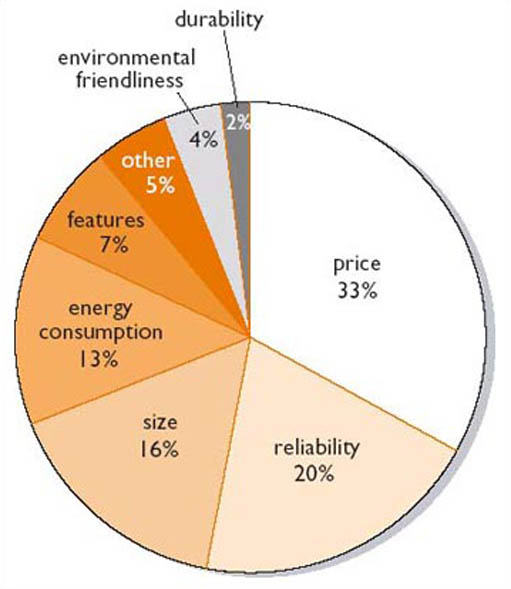4.3 The UK experience: competing trends
But one striking example does not make an argument. To try to get a fuller and possibly fairer picture of energy use by domestic refrigerators I'd like also to look at the UK experience over the past few decades.
To start with it helps to have a feel for which parts of the UK economy use the most energy. The UK Department of Trade and Industry (DTI, 1998), identifies four main economic sectors: domestic (households), industry, services and transport.
In 2003 the domestic sector (households) accounted for 31 per cent of all energy consumption in the UK, and since 1970 energy use in this sector rose by a third (DTI, 2004). Energy consumption by households, then, is both significant and rising, but it is worth noting that energy use per household has changed little during this period; this growth in demand is almost entirely accounted for by an increase in the number of households in the UK.
Looking within households, the two major users of energy are space and water heating, which in 2002 accounted for 85 per cent of all consumption. Lighting and domestic appliances, including refrigerators and freezers accounted for much of the remaining energy use, with 13 per cent or one-eighth of the total. Significantly, energy use by the groups of appliances has more than doubled since 1970. (The figure of 13 per cent above refers to the energy delivered to households through electicity. In terms of primary energy, mostly the fossil fuels needed to produce the electricity, appliances consume more like a quarter of all household energy.)
In contrast to space and water heating, which are now usually provided in the form of central heating, with gas as the major source of energy, most domestic appliances make use of electricity. Figure 6 shows electricity consumption in households for different groups of appliances during the period 1970 to 2002. The broad categories of appliance we are particularly interested in – refrigerators, fridge-freezers and freezers – are here called 'cold appliances'.

Exercise 2
There are two features of the graphs I would like to draw to your attention. Look at Figure 6 now, and make a note of:
the two appliance groups which in 1999 used most electricity, and
the two groups which have accounted for most of the increase in electricity consumption between 1970 and 2002.
Discussion
The two major uses of electricity in 1999 were the cold and lighting groups though since 1999 electricity use by cold appliances has started to decline.
The two categories of appliance that have increased electricity consumption the most are the cold and brown appliance groups. If you disagree check that you were looking for the two curves which showed the greatest rise between 1970 and 2002 (Brown goods are entertainment products including TV and audio products, VCRs and DVDs, but not computers. The unlikely term comes from the wood-coloured plastic cases of early products.) Over the period, electricity use for brown goods has risen threefold and by three and a half times for cold appliances.
What are the reasons behind the rise? Does it mean, for example, that the UK has not benefited from the improvements in energy efficiency seen in the US? In fact, the gains in energy efficiency noted for the US have also been observed in the UK, if on a less dramatic scale, for each category of cold appliance, such as refrigerator and fridge-freezer. However, until recently these improvements have been more than offset by three other factors (DTI, 1998; ECU, 1997; ONS, 1998):
an increase in the number of households (there was a 30 per cent increase in the number of UK households between 1970 and 1995);
an increase in the ownership of fridges, fridge-freezers and freezers within each household;
a change in the pattern of ownership, from predominantly fridges in the 1970s to fridge-freezers in the 1990s, which make heavier demands on electricity use.
What are the implications for future patterns of demand? Have a look now at Figure 7, which displays the trends in UK electricity consumption for different categories of refrigerator and freezer from 1970 to 2020. For the period 1970 to 1995 it shows both the rise in total demand and the shift from refrigerators to fridge-freezers. The dashed lines from 1996 are projections of future demand to the year 2020; that is, they are estimates based on certain assumptions. The figure predicts that consumption will decline steadily. It is based on recent ownership patterns and consumption trends with the modest assumption that consumers will become more energy conscious and manufacturers respond to government initiatives. How realistic is this? In 1995 the European Union introduced mandatory energy labelling for domestic cold appliances and in 1999 minimum energy standards (corresponding mostly to energy class C). Energy efficiency improved markedly after 1998 to meet these standards leading to the reductions in electricity use by cold appliances seen in Figure 6.

So far, so promising. There is considerable scope, however, for further energy savings if consumers were simply to buy the most efficient appliance available. The cold appliance group, together with lighting, has been identified as having the greatest potential for household energy saving of all electrical appliances. The researchers of the Environmental Change Unit at Oxford University (ECU, 1997), call these savings the economic and technical potential or ETP. According to them, if the ETP of the UK cold appliance group is realised, by the year 2020 its electricity consumption could fall to less than a quarter of what it is now, which would represent a dramatic change.
Of course the potential for saving is not the same as its realisation. Both consumers and manufacturers would have to be whole-heartedly committed to energy saving. In practice, when people buy consumer goods they have other things to consider, like cost and reliability. Have a look now at Figure 8. This gives the results of a small survey where people were asked to choose (from a checklist) the most important factors to influence their choice when buying a cold appliance. As you can see, energy consumption is only fourth in the order of priority. Each prospective buyer of a fridge or freezer may have their own set of criteria, but on one point we can be fairly sure: all will be considering factors other than just energy efficiency.

